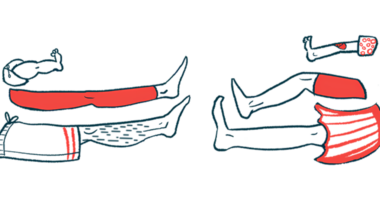Parkinson’s patients at higher risk of developing osteoporosis: Study
Five genes with diagnostic, predictive potential for both diseases identified

People with Parkinson’s disease have a nearly twofold higher risk of developing osteoporosis, a chronic condition marked by increased bone fragility, than healthy people, a study showed.
Besides identifying for the first time Parkinson’s as an independent risk factor for osteoporosis, the researchers found five genes with diagnostic and predictive potential for both conditions.
“Assessing the risk of osteoporosis in PD [Parkinson’s disease] patients and revealing the correlations between the two diseases has important clinical implications for improving early clinical screening and multidisciplinary treatment, as well as patient survival outcomes,” the researchers wrote in the study, “Cross-sectional study and bioinformatics analysis to reveal the correlations of osteoporosis in patients with Parkinson’s disease,” which was published in Experimental Gerontology.
Because of Parkinson’s motor symptoms, there is a higher risk of falling and bone fractures. Some studies have suggested that Parkinson’s patients may have lower bone mineral density (BMD; a measure of bone health) and a higher risk of having osteoporosis, which increases the risk of fractures.
These studies were mainly retrospective (using data already collected for other purposes) and restricted to specific countries, however. There also isn’t much data on possible mechanistic associations between the two aging-related diseases.
Assessing the risk of osteoporosis in Parkinson’s
A research team in China enrolled 95 people (52 men, 43 women) with Parkinson’s, but no history of osteoporosis or bone fractures due to fragility, in a study to assess the risk of osteoporosis in Parkinson’s patients among the Chinese population and investigate potential clinical and genetic links between both diseases. As a control group, 99 healthy people (55 men, 44 women) were recruited. Ages were similar between the groups, with a mean of 66 in the Parkinson’s group and 65.2 among the controls.
BMD was assessed in the lower spine, hip, and femur (thigh bone) using an imaging technique called dual energy X-ray absorptiometry. BMD is used to define bone health status — normal, slightly lower-than-normal (osteopenia), and severely lower-than-normal (osteoporosis).
Blood samples were collected to evaluate the levels of several markers of bone turnover — the process wherein old bone is reabsorbed into the body and replaced with new bone tissue.
Parkinson’s patients showed significantly lower levels of BMD in all three assessed areas and significantly worse bone health status compared with healthy controls, results showed.
A smaller proportion of Parkinson’s patients had normal BMD relative to healthy controls (27.4% vs. 38.4%) and a greater proportion had osteoporosis (31.5% vs. 17.2%). Osteopenia was detected in more comparable proportions (41.1% vs. 44.4%).
A more mixed result was seen in bone turnover markers, however. Parkinson’s patients had significantly lower levels of 25-hydroxyvitamin D — a measure of vitamin D, which promotes bone formation — and higher levels of PINP, a marker of bone formation. The other markers were not significantly different from healthy controls.
When looking at group differences for each of the three bone health statuses, the team found that among those diagnosed with osteopenia, Parkinson’s patients had significantly higher PINP levels and lower BMD on the lower spine relative to the control group.
In fact, the spinal area seemed to be the most affected in both Parkinson’s patients and controls. Studies in the U.K. and Turkey, however, have found the hip and femur to be most affected, suggesting “there are specific BMD changes in PD patients of different races and regions,” the researchers wrote. In both groups, BMD for all three bone areas decreased significantly as bone health status worsened.
In the Parkinson’s group, difficulty in performing daily activities, measured with the Unified Parkinson’s Disease Rating Scale part 2, significantly increased as bone fragility became more severe. Older age and greater difficulty with daily activities were both significantly associated with lower BMD in the spine and hip.
An assessment of risk factors for osteoporosis found that a Parkinson’s diagnosis was an independent risk factor, with patients having 1.73 higher odds of having osteoporosis than healthy controls.
Genetic associations between Parkinson’s, osteoporosis
To investigate potential genetic associations between the two diseases, the researchers used genetic data sets of Parkinson’s patients and osteoporosis patients that included healthy controls.
Comparing gene activity differences between patients and their respective controls, the researchers found 42 genes with altered activity in the Parkinson’s data set and 3,084 genes in the osteoporosis data set.
A total of 14 of those genes were altered in both diseases and five of them — SNAP25, AQP4, SV2B, KCND3, and ABCA2 —showed high levels of interaction between each other. All five genes were found to discriminate with high accuracy people with Parkinson’s or osteoporosis from healthy controls. This result suggests these five genes “have important diagnostic value and risk prediction ability for both PD and osteoporosis,” the researchers wrote.
SNAP25 is active in bone cells and has been linked to Parkinson’s brain lesions and symptom severity, while AQP4 is considered to be a key player in Parkinson’s and osteoporosis, according to the researchers.
“Our findings suggested that more attention is needed for clinicians to the bone loss situation in PD patients, and regular and thorough bone health assessments are thus required for PD patients to supplement appropriate interventions timely,” the researchers said, noting larger and multicenter studies are needed to confirm their findings, particularly ones that assess lifestyle factors like diet and exercise that can affect bone health.







